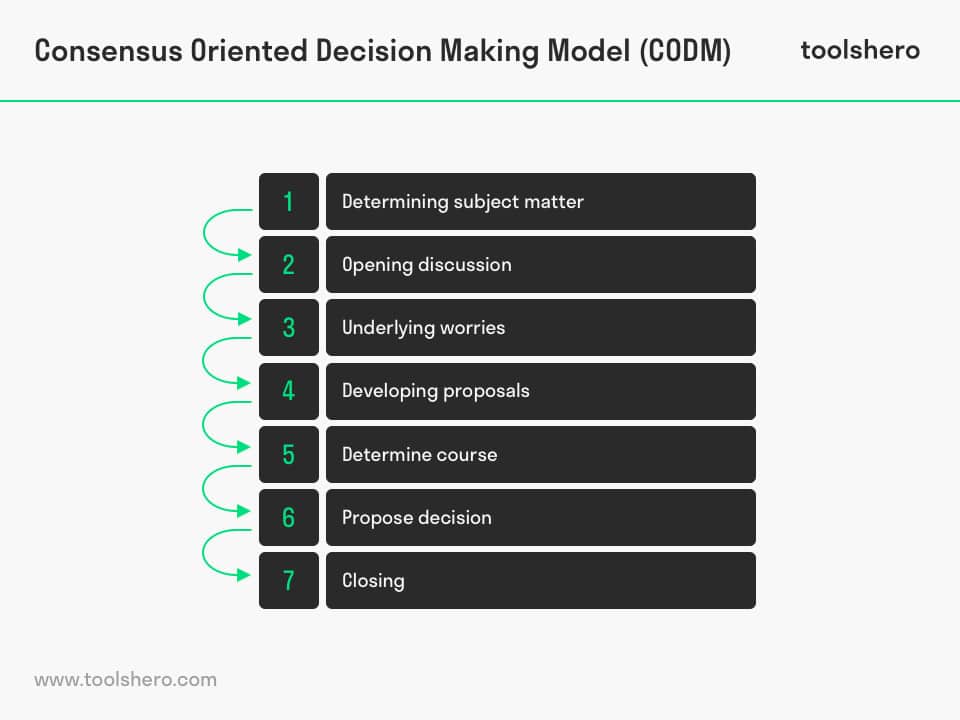Consensus Oriented Decision Making Model by Tim Hartnett

Consensus Oriented Decision Making Model: this article describes the concept of the Consensus Oriented Decision Making Model, developed by Tim Hartnett in a practical way. After reading you will understand the basics of this powerful decision making tool.
What is the Consensus Oriented Decision Making Model?
Sometimes it is difficult to come to join, efficient decision making in a group or team. With the Consensus Oriented Decision Making Model, aslo know as the CODM model, it is possible to do this step-by-step, leading to effective group collaboration.
The Consensus Oriented Decision Making Model is developed by psychologist Tim Hartnett, who works as a professional group employee, mediator and family therapist. He researched methods to ease (family)conflicts and discovered that conflict solutions and non-violent communication improved relationships.
The Consensus Oriented Decision Making Model brings people together and helps them make better decisions in which the group members feel connected. The Consensus Oriented Decision Making Model can be used to generate widespread agreements in the group in both hierarchical and egalitarian organisations.
Consensus Oriented Decision Making Model : participation
In principle, people strive for a healthy cooperation. In order to achieve this, it is important that every member of the group participates in an effective way. Only this way can joint decisions can be made and mutual goals can be realised. The effectiveness of the group is based on the ability to make good decisions. The decision making process is dependent on the effectiveness of a group.
Unfortunately, unconscious patterns like exclusion, dominance, apathy, manipulation, passive aggression or other problematic behaviours can through a spanner in the works. By applying the Consensus Oriented Decision Making Model, all group members remain alert to participate in a positive way and stimulate each other’s participation.
Consensus
In order to reach consensus, one strives for a general agreement, where most group members agree. With the common basis for all consensus processes, the following principles apply:
Everyone
As many interested parties as possible (everyone) are involved in the group discussions. All group members are encouraged to participate.
Participation
All participants get the opportunity to contribute to the discussion.
Agreement
The goal is to generate as many agreements as possible and to reach a full agreement as a group.
Process oriented
The emphasis must be on the decision making process and not just on the result. In a consensus process, all participants are respected and all their contributions are welcome.
Cooperation
All group members contribute to a joint proposal and work towards a mutual decision. Participants are encouraged to take a positive look at each other’s contribution so that all views are addressed. In the end, his personal preferences are less important than the broader group insight.
Group relationship
The group relationship is strengthened through discussion. All the perspectives of the group members lead to a strong mutual relationship, mutual trust and respect, and increased group cohesion.
Consensus-Oriented Decision-Making and efficiency
Consensus-Oriented Decision-Making combines maximum participation of the group with maximum efficiency. Through this process group members can come to better common solutions, in a way that respects all of them. Good cooperation gives the participants a greater feeling of belonging and increases their commitment.
Together they invest in order to come to a successful decision, which bodes well for efficiency. In hierarchical organisations top-down decisions are often made by the higher management. This can lead to dissatisfaction by group members, because they are not involved in the decision-making process.
Consensus-Oriented Decision-Making delivers a good alternative to reaching a compromise. By involving them, participants feel more heard, which will lead to a higher degree of efficiency.
Tim Hartnett’s Consensus Oriented Decision Making Model
The Consensus Oriented Decision Making Model, developed by Tim Hartnett consists of 7 steps, which ultimately aim to garner the entire group’s permission for the decision. This unanimity is a precondition for Consensus-Oriented Decision-Making.
It is noteworthy to mention that the participant does not necessarily have to support a group decision. As long as he can take a step aside and agrees that the majority has chosen the decision, unanimity will not be jeopardised. It is the task of the group leader to lead the entire team through all the Consensus Oriented Decision Making steps.
Step 1. Determining subject matter
By interviewing group members and collecting agenda items, the problem will be clarified. Joint determination of the subject is the introduction to the discussion.
Step 2. Opening discussion
All group members need to be encouraged to discuss with an open mind. It is the task of the group leader to provide the guidelines and structure for this and to support full participation. Every idea is welcome.
Step 3. Underlying worries
When different people engage in a discussion, there are also different opinions and underlying worries. The group leader needs to ensure that those worries are identified, collected and discussed with all group members.
Step 4. Developing proposals
In order to stimulate the process of cooperation all ideas and possible options need to pass the review. From this step, the best ideas and options are further developed and optimised in a joint process.
Step 5. Determine course
It is now up to the group leader to analyse the proposal-options and present them to all the group members in order to jointly determine the course of action that the team wants to take.
Step 6. Propose decision
By discussing any objections, dissatisfaction felt by some group members may be eliminated. Which details can lead to improvement and what needs to be included in the proposal in order to come to the best decision? Now, the group leader makes a definitive proposal that can rely on a unanimous support of all group members.
Step 7. Closing
The group leader closes off by sharing the definitive decision with the group and emphatically reacting to any dissatisfied group members. By emphasising the fact that it is a joint decision, there is a lot of support and all group members feel responsible for the execution and success of the decision.
Consensus Oriented Decision Making Model Conditions
It requires some conditions to be able to successfully come to unanimous decisions with all group members. As such, it is important to determine in advance which conditions are needed in order to reach a consensus.
There are more factors that ensure that a team will be able to make a unanimous decision. Below are the most important ones:
Small group size
The bigger the group, the more opinions and discussion there will be, which leads to a longer process to come to a unanimous decision.
- Small group size: the bigger the group, the more opinions and discussion there will be, which leads to a longer process to come to a unanimous decision.
- High degree of trust: through mutual trust, group members are better equipped to respectfully listen to each other’s points of view and possibly compromise.
- Group interest: when group members are prepared to hold the group interest in higher regard than their personal interests, it is possible to reach a joint decision faster.
In addition, it is recommended to prepare and train group members in the entire consensus process. The group members with a lot of meeting experience will know how to discuss the best and be able to work on important meeting topics. Nevertheless, the inexperienced meeting tiger can also participate in Consensus Oriented Decision Making.
It’s Your Turn
What do you think? Is Tim Hartnett’s Consensus Oriented Decision Making Model applicable in today’s modern business and team challenges? Do you recognize the practical explanation or do you have more suggestions? What are your success factors for a good decision making process, in combination with teamwork and group dynamics?
Share your experience and knowledge in the comments box below.
More information
- Hartnett, T. (2011). Consensus-Oriented Decision-Making: The CODM Model for Facilitating Groups to Widespread Agreement. New Society Publishers
- Hartnett, T. (n.d.). Consensus Decision-Making – A Virtual Learning Center for People Interested in Consensus. Retrieved 07/09/2017 from https://www.consensusdecisionmaking.org/.
- Nemiroff, P. M., & King, D. C. (1975). Group decision-making performance as influenced by consensus and self-orientation. Human Relations, 28(1), 1-21.
How to cite this article:
Mulder, P. (2017). Consensus Oriented Decision Making Model. Retrieved [insert date] from Toolshero: https://www.toolshero.com/decision-making/consensus-oriented-decision-making-model/
Published on: 10/09/2017 | Last update: 08/23/2022
Add a link to this page on your website:
<a href=”https://www.toolshero.com/decision-making/consensus-oriented-decision-making-model/”>Toolshero: Consensus Oriented Decision Making Model </a>













